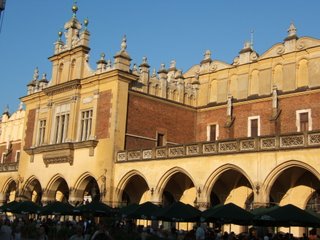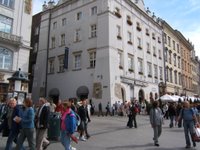
The morning brought a new day for me and Poland. The rain had stopped, rays of sun nudged me awake, and a blue sky greeted me from the window. Lisa was semi-comatose but told me to feel free to take a walk while she slept. I decided to do just that.
An entire day had been lost flying, but now I had that pleasure of suddenly finding myself on another continent. What I saw on the streets was recognizably Europe, and the sights and sounds brought me directly back to my European backpacking days. The feeling of being on a Polish street is not significantly different from being on a French or German street. There is the same strange combination of drab and colorful surroundings that is to me very distinct from America. Narrow streets with tiny cars which interestingly parked on the sidewalks.
This particular neighborhood, Kazimierz, includes the old Jewish quarter. After Steven Spielberg filmed “Schindler’s List” here in the early ‘90’s, this formerly neglected area turned into a vibrant bohemian enclave, with cafes, galleries, and restaurants of every kind popping up everywhere. The result is very NYC East Village, as the area is still somewhat run down and the influx of tourists and artists is relatively new. There are some stately old buildings, including our hotel (the Regent) and a massive cathedral in a tree-lined courtyard; there was also a large open-air marketplace where vendors were busily selling used clothing, jewelry, vegetables, framed pictures of various popes, and laundry detergent.
Back at the hotel Lisa got up just in time for us to catch the complimentary breakfast, a standard continental affair with a choice of juices, yogurts, rolls, cheese and jam. It was also apparent the Poles like their coffee strong, which suited me just fine.
To make our lives easier we booked a second night at the hotel, and then set out to discover Cracow. Just north of Kazimierz, overlooking the Vistula River, is a hill supporting the most famous castle in Poland: Wawel. It is actually an entire medieval complex including the cathedral where the kings and bishops of early Poland are entombed. As the former seat of government, Wawel is considered the spiritual heart of the Polish state. There is an old myth that a dragon resided in a lair beneath the castle; then there is a newer myth that Wawel is home to one the earth’s seven chakras, a center of energy. Sure enough, we saw people meditating in the northwestern corner of the royal courtyard.
There were lots of tourists wandering around Wawel. A Unesco World Heritage site, it has been impeccably preserved. The interior of the castle houses a network of museums and restaurants, while the well-landscaped grounds lend it a park-like atmosphere, with costumed musicians playing medieval accordion music. If I had to compare the general feeling of the place to anything, it would definitely be the new Getty Center in Los Angeles, even though the climate couldn’t be more different.
Wawel was nice but the best part of Cracow was yet to come. The road from the castle led to a triangular place with a display about the Solidarity movement, and after looking at that, we continued along a street called Grodzka, which was bustling with activity. We had just entered Old Town and were surrounded on all sides by perfectly preserved historic architecture in uplifting shades of peach and yellow ochre. I had always imagined Cracow to be a dark city, but I was wrong. What I soon realized was that Cracow, as a former part of the Austro-Hungarian Empire, belonged to the Viennese school of stately, candied architecture and coffee house culture.
On a more Polish note we passed a shop called “Greenpoint,” but unlike my former grimy Brooklyn neighborhood, this was a high-end fashion boutique. I wondered if there was a branch in Greenpoint, or if the one here was a branch of a New York clothier. Either way it seemed like another expression of my Polish destiny.

Grodzka deposited us in the star attraction of Cracow: the Rynek Glowny, or town square -- the largest such square in Europe. I’d read about it, but being there exceeded my expectations. There were not only architectural marvels but people everywhere – walking, standing, sitting in cafes drinking tall glasses of piwo (beer). It was a living, breathing town square, a welcoming place, and the true heart of present day Cracow.
At the center of the square was long structure called the Cloth Hall. We entered the south end and found ourselves in a long, open-air hall lined with vendors on either side. The vendors were selling mainly souvenirs and jewelry, and there was a considerable buzz to the place. The majority of the jewelry was amber, a natural abundance of which is found along the Baltic coast. The hall was a pleasant diversion and I was briefly reminded of the longer and narrower market place we visited in Kyoto.
All around the square and the Cloth Hall were large outdoor cafes where the serious business of eating, drinking, and people watching occurred. We planted ourselves in one next to the Cloth Hall, and in retrospect this was one of the best. In accord with Lisa’s desire for classic Polish food, we ordered plates of pierogi kapusta and pierogi russki, fresh and sprinkled with dill. We washed them down with a dark Okocim, one of the better Polish beers. A lot of calories perhaps, but delicious and vegetarian.
We noticed that most of the younger Poles in the city spoke English, and that there was a considerable amount of bilingual signage, making it a little easier to get by with our feeble grasp of Polish.

After the meal we explored many back streets, the Barbican and Florian gates, and the Planty – the park surrounding the periphery of Old Town like a moat. I’d wanted to see the art museum on the upper floor of the Cloth Hall, but it was closed. By way of compensation, we found a large gallery featuring the paintings of Olga Boznanska (1865-1940). Her work was somewhere between completely boring and perfectly subtle, the best pieces conjuring up sleepy childhood afternoons in Sea Cliff spent staring at slabs of jade, African violets and dust particles suspended in rays of sunlight.
After that we felt a little sleepy ourselves and went back to the hotel for a nap. When I realized I hadn’t had my afternoon coffee, we got up and went to the café down the street that was full of burlap sacks and photos of someone plucking beans at a tropical coffee plantation. While sitting in the café, loud music wafted in from without; upon investigation we discovered a band giving a free concert from the top of a building at the open-air marketplace. We joined the crowd on the street to listen to a set of Polish punk rock and Red Hot Chili Peppers songs.
Then we wandered around in search of a possible dinner. My instincts drew me to the far eastern edge of the Kazimierz district, where a number of ethnic restaurants surrounded a tree-lined, cobblestone square. We ended up at an Indian restaurant that claimed to have the only Tandoori oven in Cracow. Lisa said it was strange to go to a foreign country and then have foreign food (as opposed to native dishes), and in a sense she was right. But I knew I needed Indian food for balance, and even though the waiters were Polish and the Tandoori wasn’t working, the curried peas were still good, and the gentle flow of wind and people passing by our candle-lit outdoor table provided the perfect atmosphere for my sleepy, jet-lagged brain.






